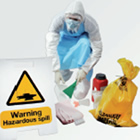Waste Management
In order to prevent damage and subsequent contamination of the environment, the drug itself or any personnel involved in handling and transport of cytotoxic drugs, packaging, storage and transport of these drugs should be executed with high care.
All packaging for storage and transport needs to be clearly labeled. If despite all precautionary messures, spillage occurs, the removal and disposal of the spilled cytotoxics should be performed by properly instructed personnel only. A spill management kit should be available in all areas where cytotoxic drugs are stored, transported, handled and administered.
Any material that has been in contact with cytotoxic drugs is considered as cytostatic waste and is - with that - hazardous waste. Cytostatic waste has to be collected in specific containers that can be hermetically sealed after filling. Furthermore the applicable national and regional statutory requirements as well as hazardous freight regulations need to be adhered. The disposal of waste needs to be precisely planned and organized in order to avoid danger to the health of people, the environment and public safety.
Especially for the transport of cytotoxic waste, dangerous goods regulations need to be adhered to.
Information on European regulations and standards of practice for storage, transport and waste management can be found in the PIC/S, p.22,
item 5.7... , in the EU GMP Guidelines, Annex 1, in QuapoS 5, p.10, 4.1-4.3, and in the ISOPP (Section 2 for transport of cytotoxics, Section 14 for cytotoxic spills, extravataion and other incidents, Section 15 for waste handling and patient excreta). Local regulations may apply and need to be considered in addition.

